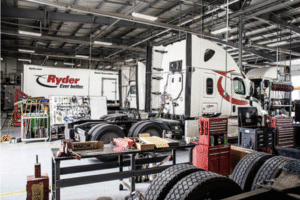DALLAS — The government’s handling of the COVID pandemic reshaped the freight market, causing a record number of new carrier registrations and spot rates to surge.
Avery Vise, vice president of trucking at FTR Transportation Intelligence, explained the details and offered analysis of the current state of the trucking industry at the Women in Trucking Association’s conference, held Nov. 5-8 in Dallas.
“People received stimulus checks,” he said. “Since so many things were shut down, they couldn’t take vacations, so they bought stuff. The spot market went crazy.”
Vise also spoke about the difficulty in finding drivers to deliver goods during the pandemic.
“The overall market, however, is that there is no shortage of drivers,” he noted, referring to the record numbers of new carrier registrations reported by the U.S. Department of Transportation (DOT) during the pandemic years.
In pre-pandemic 2019, the DOT reported an average of 27,779 new carriers added per quarter. That average jumped to 35,159 per quarter in 2020 with the third quarter seeing 42,412 new carriers. By the second quarter of 2021, new carrier registrations reached 62,578, slightly topping that number in the third quarter.
The reason? Company drivers were buying their own trucks and registering as carriers to take advantage of record-setting high spot market rates. There were as many trucks on the road as before, but more of them ran under their own authority. Spot rates peaked early in 2022 and then began falling.
By mid-2022, trucking companies were going out of business in record numbers.
The DOT reported new records in carrier revocations. Those can happen for safety reasons, but two of the biggest reasons a carrier’s authority is revoked is failure to maintain required liability insurance and failure to file required forms. Both of those events are frequently connected to a business closing.
That doesn’t mean there are fewer trucks, however. Owners who surrendered their authority can choose to lease their trucks to other carriers and continue running them. Or, they can sell their trucks and become company drivers again. Either way, the number of working trucks remains the same.
Vise pointed out that, despite being low, freight rates aren’t really that bad.
“We’re still running well above 2018 levels,” he said. “The problem is, everything else is more expensive.”
Diesel fuel averaged $3.18 per gallon in 2018, according to the U.S. Energy Information Administration. That’s up to an average of $4.19 in 2023, a 32% increase. Prices for new, Class 8 trucks have increased 22.5% in the same time period, according to the Consumer Price Index, U.S. Bureau of Labor Statistics. The cost of fluids, filters, tires and parts have all risen dramatically, too.
Federal Reserve efforts to curb inflation have resulted in higher credit costs, too. The interest rates on equipment loans have grown.
So, how did we get to a “freight recession?”
Vise cautioned that the term isn’t accurate.
“When we say ‘freight recession,’ I think we really mean ‘freight rate recession,’” he said, explaining in terms of utilization. “Utilization is very much an indicator of what’s going to happen. Utilization of 92% is not very strong.”
According to the slide shown during the presentation, utilization is “the number of seated trucks that are actually hauling freight.”
When empty trucks must travel farther to pick up loads or are unable to reload after delivery, utilization goes down. The slide showed that 92% utilization is the industry’s 10-year average. Utilization hovered between 98% and 100% for 2021 and the first quarter of 2022 before dropping. It reached a low of 88% in the second quarter of 2023 and has been slowly climbing since, but is expected to remain below average through 2024.
Simply put, there are too many trucks for the amount of freight being offered.
Improving that ratio entails more freight, produced by an expanding economy, or fewer trucks, or a combination of both.
Vise made it clear that it’s not the economy.
“The economy looks pretty good, frankly. We had a really strong third quarter with 4.9% annualized growth,” he explained.
New trucks have been built and delivered at a pace that, as of Oct. 31, was still 10.7% ahead of the 2022 pace.
August was the first 2023 month in which new U.S. truck sales were lower than the corresponding month in 2022. Sales are trending downward, but total 2023 sales will still exceed sales in 2022.
Eventually, the pendulum will swing the other way, Vise said.
Truck numbers will decrease, freight levels will rise and rates will increase, but it won’t happen overnight. FTR predicts a flat 2024 rate outlook for all trucking segments.
It will take time to remove the excess capacity from the market, while the economy in terms of Real GDP is expected to grow at a rate under 2% for 2024.
Cliff Abbott is an experienced commercial vehicle driver and owner-operator who still holds a CDL in his home state of Alabama. In nearly 40 years in trucking, he’s been an instructor and trainer and has managed safety and recruiting operations for several carriers. Having never lost his love of the road, Cliff has written a book and hundreds of songs and has been writing for The Trucker for more than a decade.















